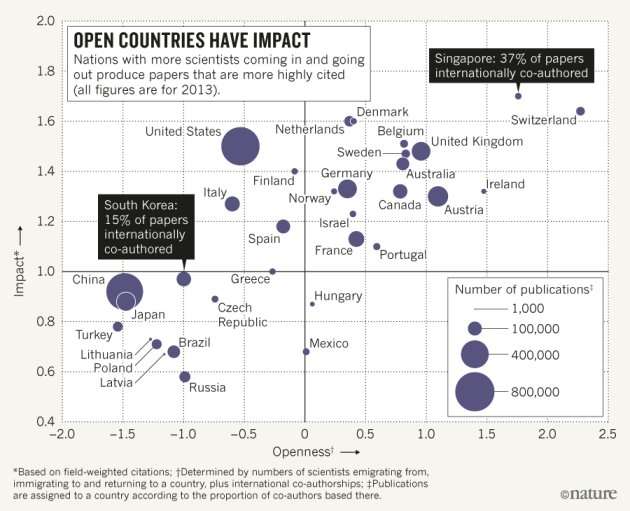Credit: (c) Nature 550, 32–33 (05 October 2017) doi:10.1038/550032a
(Phys.org)—Two teams of researchers working independently have come to roughly the same conclusion: Researchers that are free to move between countries produce results that are more creative and innovative than do those that stay at home. The first team led by Cassidy Sugimto of Indiana University has published a Comment piece in the journal Nature describing their study of citation rates of researchers who travel versus those who do not. The second group, made up of the two researchers Caroline Wagner with Ohio State University and Koen Joners with the European Commission's Joint Research Centre in Brussels offer their findings regarding comparing the scientific influence of researchers by country in a Comment piece in the same journal edition.
Common sense suggests that scientists who collaborate with partners with varied backgrounds are likely to have more success in finding innovative and creative solutions to scientific problems than are those who face travel or cultural restrictions. Now, it has been demonstrated statistically.
In the first effort, the researchers analyzed 14 million research papers published in journals through the years 2008 to 2015, which included approximately 16 million researchers. In so doing, they discovered that approximately 4 percent of those researchers listed as authors could be classified as mobile—meaning they were cited in papers with teams in different countries. They further discovered that these mobile researchers had 40 percent higher citation rates than did non-travelers. The team also noted that North America and Northern Europe attracted researchers from other countries more so than other regions.
In the second effort, the researchers compared science expenditures between countries by analyzing 2.5 million published research papers from 2013 with researchers in 36 countries. They also looked at the mobility of international co-authorships of the research workforce in general. They report that open countries tend to produce science that they describe as both more creative and innovative than do countries that have closed borders (as measured by citations). They note also that some countries, most notably Singapore and Switzerland, have outsized influence (scientific impact versus population size) due to their international relationships. They found that others, such as South Korea, are having less of an impact despite spending a lot of money on research, likely because of their limited number of international collaborations.
More information: Cassidy R. Sugimoto et al. Scientists have most impact when they're free to move, Nature (2017). DOI: 10.1038/550029a
Caroline S. Wagner et al. Open countries have strong science, Nature (2017). DOI: 10.1038/550032a
Journal information: Nature
© 2017 Phys.org





















